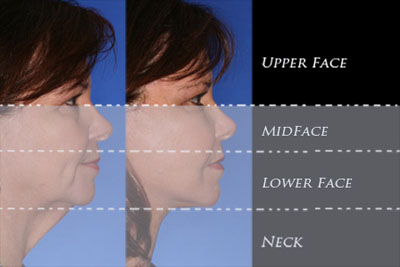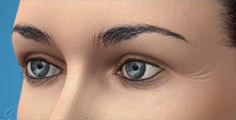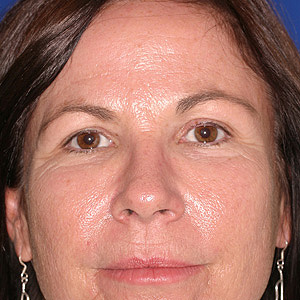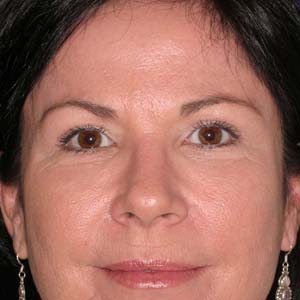upper-face-rejuvenation2
Upper Face Rejuvenation
Approach to the problem areas of the Upper Face
Below, we have listed the six most common concerns regarding the upper face. Remember, the entire concept of CustomLift® is to identify which of these issues are of concern to you AND the relative importance of each concern. With this information, you can then intelligently outline which procedures are best suited for you. Unfortunately, with time everyone will experience aging to ALL six areas but this does not mean that each must be addressed at the same time.

- Upper Eyelid.
The most common problem with the upper eyelid is excess skin. Fat excess is rarely a problem except in the Asian community. In fact, the upper eyelid area LOSSES fat with age and becomes hollow and gaunt. Sometimes, there is a little bulging fat pad right next to the nose but aside from this all fat in the eyelid is precious and should be preserved. If you have this fat pad it is located just above the corner of the eye near the bridge of the nose. This should be removed at the time of upper blepharoplasty.

Animated Upper Eyelid
Scroll over the image to see the effects of a skin removal from the upper eyelid. Notice how the crease is more defined and the eyes look more rested.
Scroll over the image to see the effects of a skin removal from the upper eyelid. Notice how the crease is more defined and the eyes look more rested.
What does the Upper Blepharoplasty do?
CustomLift®'s approach to upper blepharoplasty is to remove the excess skin to define the upper eyelid and give it a youthful appearance. In women, this means creating an elegant, defined upper eyelid. This allows makeup to go on easily without smudging. The size of the upper eyelid is up to the patient. Men require a less dramatic result. They do not tolerate an "operated on" appearance.
How do I know if an Upper Blepharoplasty will help me?
If the skin of the upper eye lid hangs down over the eye lid you would benefit from an upper blepharoplasty. Typically, this excess skin is easily pinched and feels "paper" thin.
Patient with significant excess skin and hollowing of the upper eyelid. Notice how rejuvenated the post-operative picture looks, without an "operated" appearance.
- Temple Region, Crow's Feet, and Outside Corner of the Eye
This is the area of the upper face that ages the quickest. Yet, it is often not addressed by most plastic surgeons. The temple region is the outer corner of the eye and the outer part of the eye brow. Typically, lifting the temple with a Temple Lift creates dramatic improvement in appearance. The nice thing about the temple lift is it can easily be done under local anesthesia with or without a blepharoplasty.
Notice tired and hooded appearance of outer part of the eye and eyebrow. Notice the bright and elegant appearance after temple lift and upper blepharoplasty.

Animated Temple Lift
Scroll over the image to see the effects of a temple lift. Notice rejuventaion of outer brow, outer corner of the eye and crow’s feet.
What does the Temple Lift do?
The temple lift does several very important things in terms of rejuvenating the upper face. It lifts the outer corner of the eye. This dramatically improves the hooding of the outer eye that often makes you look sad even when you are not. It raises the outer part of the eye brow creating a very elegant look. In fact, it can often replace a brow lift completely. Finally, it removes the crow's feet that are caused by excess skin.
Correction of crow's feet with upper eyelid surgery and temple lift.
How do I know if a Temple Lift would help me?
 The best way to see if a temple lift would benefit you is to elevate your temple and see if you like the look. Simply, place the finger tips of your index, middle, and ring finger right at the hairline of your temple and elevate it gently; not too much because this will over correct. Chances are this will dramatically create a more youthful, elegant appearance.
The best way to see if a temple lift would benefit you is to elevate your temple and see if you like the look. Simply, place the finger tips of your index, middle, and ring finger right at the hairline of your temple and elevate it gently; not too much because this will over correct. Chances are this will dramatically create a more youthful, elegant appearance.
Using the CustomLift® custom face lift approach, Joseph T Cruise, MD routinely performs both an upper blepharoplasty and a temple lift at the same time. This rejuvenates the entire upper face. Best of all, both can be easily done under local anesthesia without pain.
- Brow Position
With aging and loss of facial volume, the brow routinely drops down. Sagging of the brow is almost never uniform. The outer part of the brow almost always sags more than the inner part. See if this applies to you. If only the outer part of the eye brow has fallen (which is often the case) then a temple lift is the best choice for correction.
If the entire brow has fallen, then a brow lift may be necessary. I say "may" because the CustomLift® approach prefers to correct the problem at its cause. Often the brow falls because the upper eyelid/brow area has lost significant fat.
Example of one sided brow sag. Right brow corrected with brow lift.
The loss of fat volume causes the brow to descend and the upper eye to look hollow. The best way to correct this is to perform a temple lift to raise the outer brow and to replenish the lost volume with either fat or a soft tissue filler.
By correcting the cause of the problem, facial rejuvenation looks much more natural.
What does a Brow Lift do?
A brow lift elevates both the inner and outer part of the brow. The temple lift elevates only the outer part of the brow.
How do I know if a Brow Lift will help me?
It is far more likely that you will need a temple lift. The real question in the CustomLift® approach is whether or not you need a brow lift in addition. You can check this by first imitating a temple lift as described above. If the central part of the brow still seems low than a brow lift is most likely necessary.
As you can tell, I am much less enthusiastic about the brow lift than I am about the temple lift. This goes back to the CustomLift® principles. The temple area and outer brow fall much earlier and more significantly than the central and nasal part of the brow does. Therefore, this is the area that should be addressed first. There are too many people walking around with an unnatural "surprised" appearance to their brow because their surgeon did not address the problem at its cause.
By correcting the cause of the problem, facial rejuvenation looks much more natural.
- Sunken, Hollow Appearance of Upper Eyelid
This area is a perfect continuation of the brow area. As mentioned above, the brow often falls because the brow area and upper eyelid losses fat with age. Not only does this drop the brow but it causes the upper eyelid to appear sunken and hollow.
Traditional plastic surgery principles would treat this problem with a tight upper blepharoplasty and a brow lift. This often leads to a hollow, surprised appearance that actually looks unnatural. CustomLift® principles treat this problem by replacing the lost volume with a soft tissue filler or fat which, after all, is the root cause.

Animated Fat Transfer to Upper Eyelid
Scroll over the image to see the effects of a fat transfer to upper eyelid. Notice how the fat replenishes lost volume necessary for a youthful appearance.
What are soft tissue fillers?
 There are two distinctly different types. One type comes packaged and ready to inject. You probably have heard of them by name, i.e. Restylane®, Juvéderm™ , Radiesse, etc. The other type is your own fat. Obviously, this needs to be removed from elsewhere on your body, purified, and then re-injected. The clear advantage of the packaged soft tissue fillers is that it does not require a donor site and is much simpler with less down time. The advantage of fat is that it lasts forever.
There are two distinctly different types. One type comes packaged and ready to inject. You probably have heard of them by name, i.e. Restylane®, Juvéderm™ , Radiesse, etc. The other type is your own fat. Obviously, this needs to be removed from elsewhere on your body, purified, and then re-injected. The clear advantage of the packaged soft tissue fillers is that it does not require a donor site and is much simpler with less down time. The advantage of fat is that it lasts forever.
 |
 |
 |
|
How do I know if I need a soft tissue filler for the upper eyelid?
This is best done by first simulating a temple lift with your index, middle and ring fingers.
Now, look at the upper eye lid. Is it hollow? Does it look sunken? If so, a soft tissue filler will help immensely. The good news is that it is relatively quick with little to no down time. A huge advantage of the packaged soft tissue fillers for the upper eye lid is that they last much longer than they do in the lips or naso-labial folds. They can last up to two years.
- Crow's Feet and Forehead Wrinkles
 Wrinkles that are caused by facial expression are best corrected with Botox®. As mentioned earlier, crow's feet that are caused by excess skin are removed by performing a temple lift. Crow's feet that only occur during smiling need Botox®.
Wrinkles that are caused by facial expression are best corrected with Botox®. As mentioned earlier, crow's feet that are caused by excess skin are removed by performing a temple lift. Crow's feet that only occur during smiling need Botox®.
 |
|
 |
|
| Static Crow's Feet corrected with Temple Lift | Example of face at rest and dynamic wrinkles. Those can be best addressed with BOTOX® |
The results from Botox® can be amazing and has essentially no down time. The obvious draw back is that it only lasts 4 to 5 months.
- Sun Damage and Poor Skin Quality
With age and sun damage many unfavorable things happen to facial skin. The surgical procedures above address how to manage excess skin, skin sag, volume loss, etc. The most difficult problem to correct is poor skin quality.
Aging causes the dermis to thin. This, along with sun damage, causes the skin to loose its elasticity. Therefore, neck skin that would snap back in a 30 year old becomes saggy skin in a 50 year old.
How can the skin quality be improved?
The CustomLift® custom face lift addresses poor skin quality with two modalities. One is a TCA chemical peel. This penetrates the dermis causing it to heal with thicker and more elastic dermis. It has anywhere from a 3 day to a 2 week recovery period depending on how strong of peel is desired. The most impressive result of a chemical peel is how it gets rid of the aged spots caused by sun damage.
Sun damage corrected with chemical peel. Notice the dramatic improvement of skin quality.














